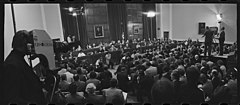Impeachment process against Richard Nixon First day of the House Judiciary Committee's formal impeachment hearings against President Nixon, May 9, 1974 |
| Date | October 30, 1973 (1973-10-30) – August 20, 1974 (1974-08-20) |
|---|
| Venue | Rayburn House Office Building
(staff headquartered at House Annex-1) |
|---|
| Location | Washington, D.C. |
|---|
| Cause | Watergate scandal |
|---|
| Target | Richard Nixon, 37th president of the United States |
|---|
| Organized by | United States House Committee on the Judiciary |
|---|
| Participants | 38 members of the Judiciary Committee, Peter Rodino, chairman; also, Lead counsel John Doar, Attorney James D. St. Clair, among others |
|---|
| Outcome | Resolution containing three articles of impeachment adopted July 30, 1974; resolution became moot August 9, 1974 when President Nixon resigned from office[1] |
|---|
| Charges | Adopted: obstruction of justice, abuse of power, contempt of Congress
Rejected: usurping congressional war powers, tax fraud |
|---|
The impeachment process against Richard Nixon began in the United States House of Representatives on October 30, 1973, following the "Saturday Night Massacre" episode of the Watergate scandal.
The House Committee on the Judiciary set up impeachment inquiry staff and began investigations into possible impeachable offenses by Richard Nixon, the 37th president of the United States.
The process began on February 6, 1974, when the House granted the Judiciary Committee authority to investigate whether sufficient grounds existed to impeach President Nixon of high crimes and misdemeanors under Article II, Section 4, of the United States Constitution.
This investigation happened one year after the United States Senate created the Select Committee on Presidential Campaign Activities to investigate the 1972 break-in at the Democratic National Committee headquarters at the Watergate hotel in Washington, D.C..
On August 9, 1974, before the full House could vote on the articles of impeachment, Nixon resigned. This ended the impeachment process.
References